In 1982 I quit a teaching job at Skidmore College. It would not be the last time I fled the clutches of higher education. Together with Vicki Davila, whom I had recently married, we moved from Saratoga Springs to Philadelphia. Both of us had grown up in the Delaware Valley, and attended college at the Tyler School of Art. In many ways, it was a homecoming. We acquired a property in Queen Village. During its renovation we lived a mile to the north, on the 300 block of Brown Street in The Northern Liberties. Our apartment was situated on the top floor, with access to a small the rooftop deck, affording broad vistas of what was then a low-rise city. At the time, this now fashionable area was still quite rugged. Dilapidated buildings lined potholed streets inhabited by rough characters and seedy bars. The view from the rooftops offered a different kind of landscape. The sweeping arc of the Interstate highway rose up like a whale, from a sea of decaying architecture. The skyline was punctuated by billboards and the smokestacks. The heaving bulk of Shackamaxon power station lay beyond. Penn Treaty Park lay beside it on the right bank of the Delaware River. Here in 1682, William Penn negotiated the purchase of lands that later became The Keystone State from Lenni-Lenape Sachems. Saki-mauch-een-ing (Shackamaxon) was the Lenape equivalent of Westminster Abbey. The site was designed for the ceremonial investiture of Lenape chiefs, whom pacifist Quakers hoodwinked at that very place.
From 1982-83, my studio was located on the second floor of what had once been a Masonic Hall, across the Fairmount Avenue from the modest row house where in 1902, Larry Fine of Three Stooges fame had been born. My landlord was Robert Betty, who owned the building and operated Mangam Organ Company, on the ground floor. The atelier built and repaired traditional pipe organs. Philadelphia was , and remains famous or its music industry. Apart from its world-class orchestra, the city had been home to many Jazz greats like John Coltrane, Dizzy Gillespie and Billie Holiday. The pop music television show American Bandstand was first broadcast from Philadelphia.
Oil sketches made from our Brown Street rooftop captured the visual syncopation of the city; its rhythmic geometry, character, and textures, played out on Northern Liberties rooftops. These later inspired a number of finished compositions, one of which was acquired by master violin maker William Moennig; the brother of actress Blythe Danner.
In 1983, we moved into our newly-renovated home; a former taxicab garage on Fulton Street in the Queen Village neighborhood of South Philly. Instead of peeling tarpaper, rusting cornices, crumbling chimneys and stucco falling in sheets of weathered bricks, the adjoining buildings hummed with new HVAC units. Raft-like, roof-decks floated in a lagoon of masonry. Gleaming skylights and television antennas broke the surface, stretching away to City Hall tower, crowned by Calder’s Billy Penn. To the east stood the the Benjamin Franklin Hotel and the Philadelphia Savings Fund Society, the first modernist building in the International Style, designed by Lacaze & Howe in 1932. Nearby was the spire of Saint Peter’s Episcopal Church, the graveyard of which holds the bones of Charles Willson Peale. In the distance was seen the hulking Customs House. These views developed into monumental compositions, drawing praise from the late Edmund Bacon, Philadelphia’s Robert Moses, whose impact on the city remains a matter of controversy.
Like many origin-myths, the genesis of this body of work did not follow a straight path. My interest had always been more keenly focused on the natural landscape. Cityscapes were convenient. On many days I might paint along Schuylkill Banks, or drive up the Delaware Valley to Bucks County. These were not my quotidien terrain. Nor at the time had I developed a coherent narrative, beyond my desire to work in a certain way.
Vicki and I had gone to Santa Fe in 1982, to spend Christmas with her family. On many days, I would venture into the terrain, making sketchbook drawings, painting in gouache on location. The idea of painting in books had not yet come to me.
Excursions took me to Pecos, Cochiti Canyon, Black Mesa, Acoma, Chaco Canyon, Bandelier National Monument and the ruins of Pecos Pueblo. Covered in snow, these sites in winter can be desolate and haunting.
Returning to Philadelphia after the first of the year, I began a series of large scale paintings inspired by my work in the field.
I never copied my sketches, which gathered impressions that could be developed into durable memories upon which I could draw. Each studio foray failed to capture the specificity and spontaneity of my open-air works from New Mexico. It dawned on me that despite painting in New Mexico for nearly a month, my depictions of Southwest ruins and geology had been filtered through my familiarity with architectural forms and spaces, back home in the East. Within a few days, my large paintings of New Mexico had been transformed into views of Philadelphia. Suddenly, it all made sense.
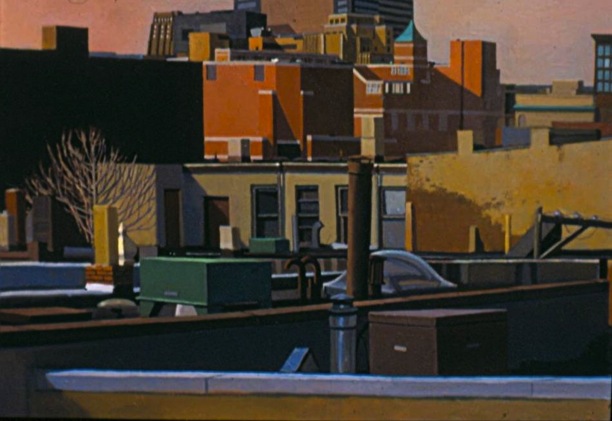
The series of paintings that followed progressed for several years, yielding canvases that ranged in size from thirty by fifty inches, to six by eight feet. Several large drawings were produced at the same time, none of which survive.
The discovery for me was the unexpected randomness of the urban environment, which from the prospect of a rooftop could seem organic, like a coral-reef, or a field of pumpkins. Some effort might be exerted to maintain a coherent streetscape. The ever-present mayhem caused by automobiles, commercial signage, and the astonishing vicissitudes of personal taste challenge order at every turn.
Rooftops are different. These are realms of neglect and privacy. Living amongst the rooftops of Philadelphia, I beheld people engaged in quarrels, burglaries, police activity, barbecues, sunbathing and alfresco lovemaking. They felt secure–even invisible–on their own rooftop. Privacy often relies on the discretion of others.
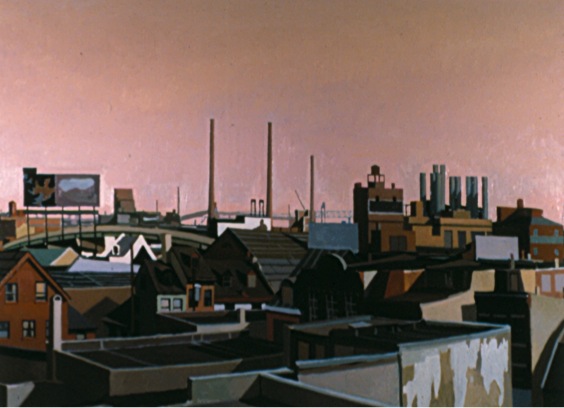
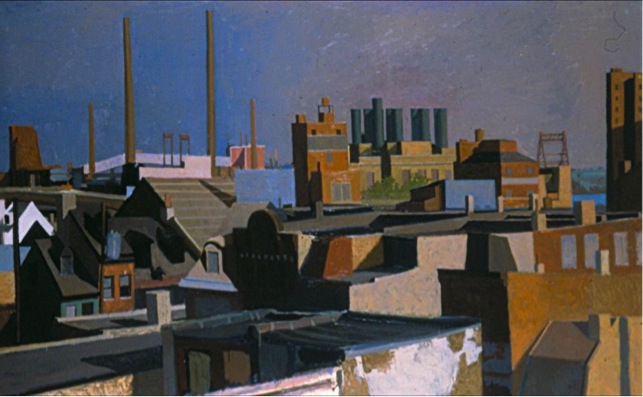
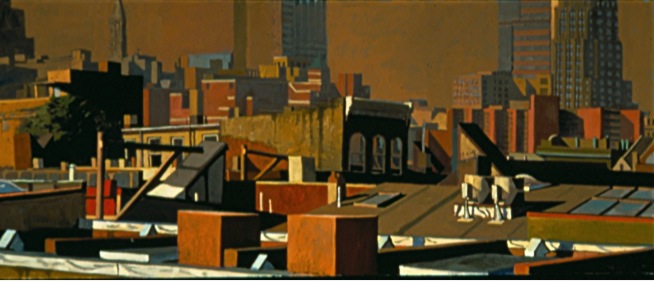
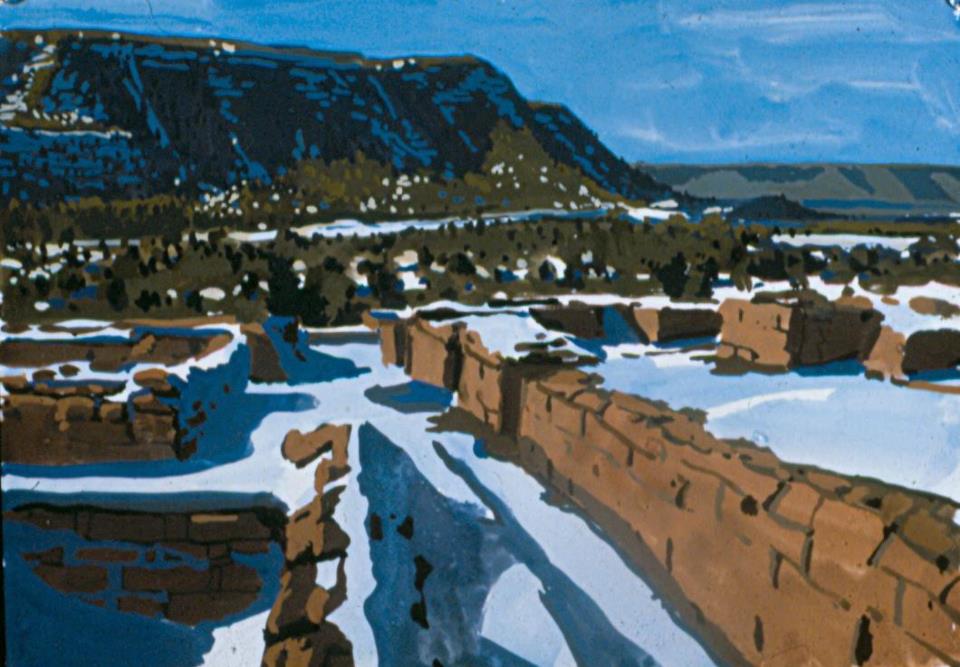
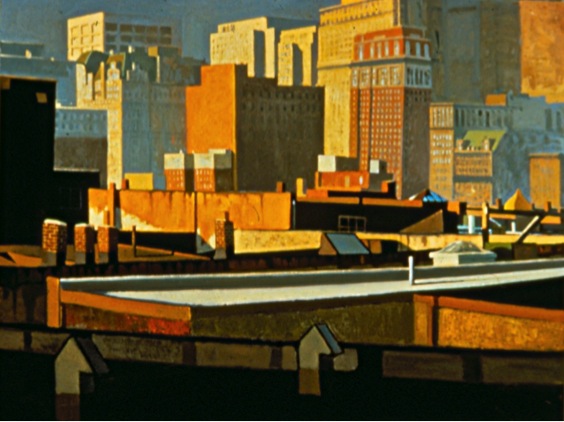
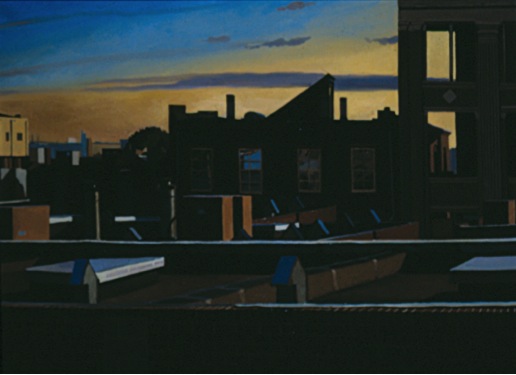
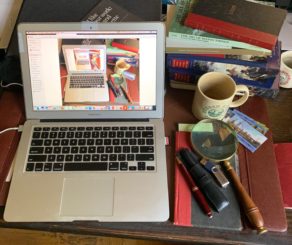
 Facebook
Facebook Twitter
Twitter Linkedin
Linkedin